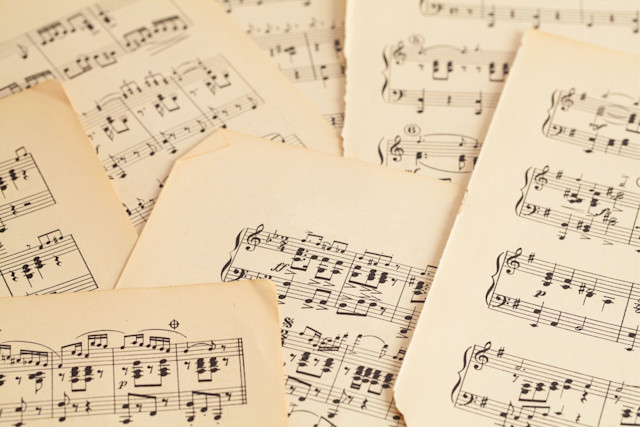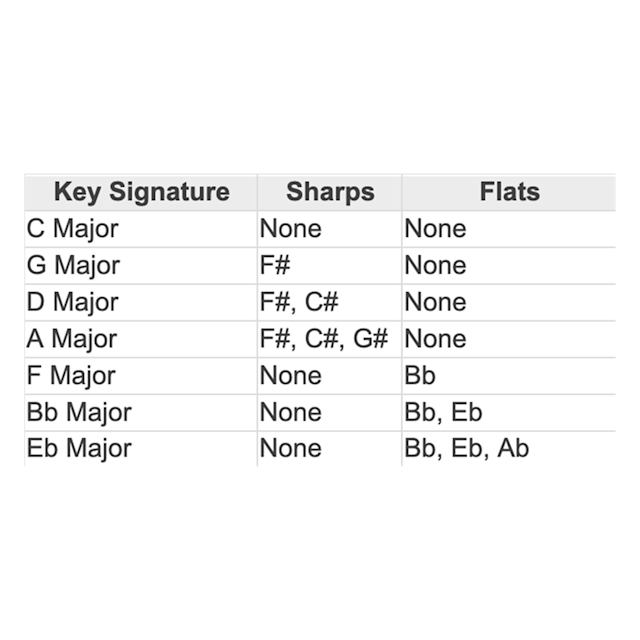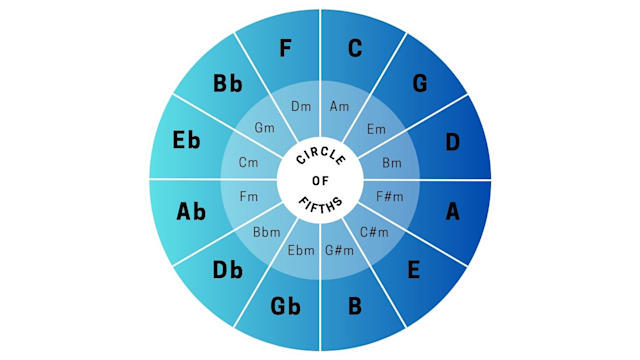Basic Music Theory: An Introduction for Producers and Songwriters
August 29, 2023 / Tero Potila

Music is a universal language of emotion. So, what do we need music theory for?
Music theory is like the blueprint of music. Yes, you can feel music without understanding its theory, but it is essential to deepen your understanding and become a better creator. By studying basic music theory, you become more fluent in the language of music.
This guide will help you understand the essentials of music theory, whether you're a beginner or a music professional needing a refresher. From notation to rhythm, scales, chords, keys, and more, you'll be equipped with the knowledge to express yourself musically and make your compositions shine.
Basic Music Theory: The Foundation
Music theory aims to set a standard way of communicating musical ideas. This makes it possible for musicians to work together.
By learning these concepts, you can better understand how music works. It also makes you a better listener and music creator and, of course, a better communicator when working with other musicians.
Who Music Theory Is For
Music theory can benefit anyone interested in deepening their understanding of music. You don't have to be a professor of music!
Do you enjoy immersing yourself in music while you relax after a long week? Learning music theory will deepen your understanding and connection to your favorite songs. Do you like coming up with licks and riffs on your guitar? Understanding music theory will enable you to take your guitar playing to the next level.
Many self-taught musicians think studying music theory would hinder their ability to be in the moment and play purely by feel and instinct. Music theory aims not to take the creativity out of your playing but to arm you with the tools subconsciously so that you can translate your 'feel' to music in even more detail.
You can paint a much more detailed picture of your musical ideas. Fully grasping the concepts of music theory helps you to be more in the moment and create music that is true to your instinctive ideas.
You can study music theory in schools, and there are many amazing courses. But you can also study it on your own and incorporate music theory into your playing and creative process as you learn more.
Start From the Beginning
The blueprint of every musical composition includes these core concepts: melody, harmony, and rhythm. They help you intuitively to connect with music.
Building Blocks of Music Theory
Melodies, harmonies, and rhythms are made up of some principal building blocks:
Scales: A sequence of half and whole steps that form the foundation for melodies.
Chords: Combinations of notes played simultaneously, such as basic major and minor chords, create harmony.
Keys: The tonal center of a piece of music, used to establish a sense of harmony and guide the relationship between chords.
Music Notation: The symbols used to represent musical sounds, such as pitch and rhythm, on a written score.
Scales
Scales are patterns of pitches that are the foundation for melodies. In music, pitches are referred to as notes. They are a specific collection of tones and semitones defining the notes in a melody.
These patterns establish the unique sound of a scale and how it functions within a song.
There are multiple scales with their specific moods, emotions, and characteristics. The most common scales are the major and minor scales; the major scale sounds happy, and the minor scale sounds sad.
The difference between the happy and sad is mainly defined by the 3rd note of the scale, wherein the major scale is a tone up from the 2nd, and in the minor scale, it is a semitone step up. In Western music, the 3rd is the scale's most important and defining note since it sets the overall mood and sound.
There are numerous other scales, each with a distinct melodic signature. Some examples include the pentatonic scale and its more evolved relative, the blues scale, the chromatic scale, and many more.
Understanding scales and accompanying chords is crucial when creating music, as they significantly influence a song's sonic identity. Exploring different scales can unlock new melodic possibilities and elevate your composition skills.
Chords
Chords are a collection of notes played together. They are the building blocks of harmony in music. Chords typically consist of three or more notes. The three-note group in a chord is called a triad.
The same relative steps system from the scales is also applied to chords. These steps between the notes are known as intervals.
Here are four basic types of chords:
Major chord: These have a happy, bright sound and are made up of the root, major third, and perfect fifth intervals.
Minor chord: These have a sad, darker sound and are made up of the root, minor third, and perfect fifth intervals.
Diminished chord: These have a tense, unstable sound and consist of the root, minor third, and diminished fifth intervals.
Augmented chord: These have a mysterious, dramatic sound formed by the root, major third, and augmented fifth intervals.
Chords can be combinations of major and minor triads and chord inversions, which describe how the notes are arranged within the chord structure.
Exploring different chords and their interactions is key to defining the identity of a song. For example, if we take a basic major triad, instead of being structured 1-3-5, we move the 5 on the bottom, giving the chord a completely different emotion.
The basic structure in songwriting consists of a sequence of chords known as a chord progression. Once you become more skilled at arranging the chords together, you can expand your songwriting to a more advanced level.
Understanding chords, from basic chord shapes to extended chords, can help you create richer and more captivating music.
Read more: Chord Progressions Explained - How to Write a Song With Instruments

Keys
A musical composition consists of major or minor scales, providing a framework for musicians to work within. This is called a musical key. It sets the foundation for the composition.
A key signature is a set of sharp (#) or flat (b) symbols placed at the beginning of a piece of music, indicating the key in which the piece is written. The sharp symbol indicates that the note should be played a semitone higher than its standard pitch, and the flat symbol indicates it should be played a semitone lower.
A key signature helps guide your understanding of the scale and harmony of the composition. This simple table will help you identify some common key signatures.
A composition can transition to a different key. These are known as key changes. Key changes are a great tool for adding a new depth of emotions and perspective. Some styles of music apply key changes more than others; modern pop music typically uses it sparingly, while a video game score may have multiple key changes in a short span.
Understanding the relationship between different keys is essential. The Circle of Fifths is a helpful tool for visualizing these relationships. Picture a clock face with keys replacing the numbers.
Read more: Guide: Circle Of Fifths In Music Theory Explained

The Circle of Fifths arranges keys by their number of sharps or flats, with C major at the top.
Music Notation
Notation is the written language of music. It enables you to communicate your musical ideas visually and others to read and understand them.
Here's a brief overview of various elements in music notation:
Staff: The staff consists of five horizontal lines where musical symbols indicate pitch and duration.
Clefs: A clef assigns a particular pitch to a specific line on the staff. The most common clefs are treble (used for higher pitches) and bass (used for lower pitches).
Notes: Notes represent the pitch and duration of a musical sound. They're indicated by symbols placed on the staff. The position of the note within the staff corresponds to the pitch; if the note is higher on the lines, its pitch is higher. The notes are also divided into structures that represent the rhythm of the composition
These elements form the basic framework that the scales and chords in the composition will follow.
Once you become familiar with this language, you can read and write sheet music and completely understand it without hearing it. It will make understanding basic music theory concepts easier as you can study them visually. Communicating with other musicians will improve drastically as you share a common language.
Rhythm
Rhythm is just as essential to music as chords and scales, and music notation has specific elements and rules that communicate the composition's rhythmic details.
A time signature defines how many beats are in a measure and which note value receives one beat. It is typically written as a fraction, with the top number representing the number of beats per measure and the bottom number representing the note value that gets one beat. For example, a 4/4 time signature means four beats per measure, and a quarter note gets one beat.
Rhythmic patterns can range from simple to complex combinations of multiple patterns. These are called polyrhythms and can be used to create unique rhythms.
Understanding rhythm will also help your music production workflow in your favorite Digital Audio Workstation (DAW), where the notes are typically edited in a Piano Roll window displaying music scales on the piano's black and white keys. DAWs also have the capability to apply swing adjustments and other rhythmic presets to your music.
Compositional Elements
As you advance, exploring various compositional elements that contribute to making a piece of music more engaging and expressive is crucial. Here are some essential concepts:
Dynamics: Refers to the music's volume, affecting the sound's intensity and energy. Common markings used in notation include the words piano (soft) and forte (loud).
Articulation: How individual notes are played or sung, such as staccato (short and detached) or legato (smooth and connected).
Form: A piece's overall structure or design, such as verse-chorus-verse-chorus form in popular music or a sonata form in classical music.
Texture: The arrangement of multiple layers of sound or voices in a piece, such as monophonic (single melody) or polyphonic (multiple melodies).
Ear Training
Understanding music theory as a concept sets the foundation. The next crucial step is learning to hear these theoretical concepts in music.
Ear training is important in connecting the theory to real-world applications. By listening, you can improve your ability to recognize musical elements such as intervals, chords, and melodic and rhythmic patterns.
Once your ear can recognize the theoretical concepts, you can apply them in your composition and performances.
This is where we come to a full circle; just as I talked about playing by feel and instinct at the beginning of this article, connecting the dots between theory and ear training will enable you to do just that. The theoretical concepts will become second nature; you can listen, perform, or create music without thinking about them.
Developing this skill is the vital connection between theory and practical application.
Wrapping Up
Once you understand music theory concepts and learn to hear them, you can apply this new skill and knowledge to your projects.
Whether jamming with a band, working on music composition, or producing music in a DAW, you can take your work to the next level. A better understanding of the rudiments of music theory will help you create better music and enjoy the process more than ever.
The concepts we covered here are the primary building blocks of all genres, whether we're talking about classical music with complex compositional structures or modern popular music with simpler chord progressions and melodies that become massive hits.
About the author
Tero Potila is a professional music composer and producer. His career combining knowledge and experience from music, TV, film, ad, and game industries gives him a unique perspective that he shares through posts on teropotila.com.
Get started with Soundtrap today!